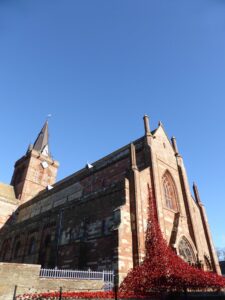
I’ve been thinking about the concept of persistent places. That is the idea that a place may be occupied for centuries, even longer, on the basis that it is special. A sacred site, for example, may continue to be visited or occupied long after the original activity, and perhaps meaning, has ceased. A landscape may have particular significance that lingers in local consciousness and makes it special and thus attractive to the community.
We often see activity in a location well beyond the lifespan of the original structure or event. Brochs, for example, frequently have surrounding settlements that continue in use well after the original broch tower has fallen into disrepair and in some cases the structure itself may be dismantled and even rebuilt to conform to new requirements. But I think we need to be careful of over ritualising the landscapes and activities concerned.
My town, Kirkwall, has, for example, been settled at least since the time of the Norse. The church of St Olaf, was built about 1035 between the Papdale Burn and the sea. Some have argued that there was a Christian community here before that, and archaeological investigation records activity going back, at least, to the Bronze Age. Today, we have a well-loved cathedral and Kirkwall is certainly a significant religious and political centre for the inhabitants of Orkney. Almost half of us choose to live here.
But I am not sure that we live here for the same reasons as the prehistoric inhabitants of the area. And, though the cathedral is important, I suspect that its presence was not the deciding factor for many of the present population. Kirkwall has many conveniences: local shops and supermarkets, restaurants, library, cinema, sports and leisure centre, hospital and so on. In other words, we, ourselves, have created the factors that make this a persistent place.
It is a difficult conundrum to puzzle out the origin of the elements that make somewhere special. And of course, they are likely to change over time, just as lives have changed over time. I find it pretty amazing to consider that I look out over the same bay that has been appreciated by the population of Kirkwall for around 1000 years and, of course, the basic requirements that are met by the area have, in some ways, stayed the same: food; transport; relaxation; companionship; and spiritual life. But this is due as much to the work of the generations who have lived here down the centuries as it is to any intrinsic qualities of the area.
Yes, of course, there are sacred sites that remain sacred. There are sacred sites that remain significant, if changed in use (Stonehenge). There are significant sites that remain popular. But, in most places, it is the combination of people and nature that serves to produce the persistent place. Not simply the location.
It is a good example of the deep entanglement between people and nature.
You must be logged in to post a comment.